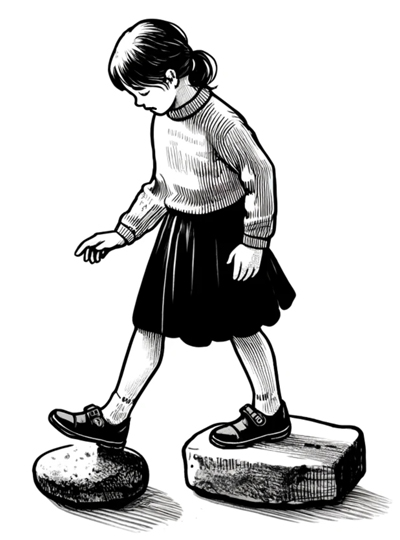Bedtime anxiety – what’s going on or not going on?
|
Bedtime anxiety in children means feeling unsettled, disturbed or worried about falling asleep, or worrying they won’t be able to get back to sleep if they wake in the night. |
Most parents find bedtime can become a bit of a challenge as their child gets older.
There are obvious and understandable reasons for a child's general reluctance to go to bed.
The following well-known behaviours before bed are not usually ones that show your child is anxious or worried:
- Wanting to stay up as long as an older sibling
- Wanting to join in with what the rest of the family is doing
- Refusing to stop a bedtime-reading book
- Throwing a strop about turning off a device, tidying toys, getting in the bath etc
- Jumping out of bed the minute your back is turned.
These behaviours are about temperament, growing up, challenging authority and generally throwing their weight around – until you give in. The best advice for these situations is… Don’t! Once you give in, they have you over a block.

When words can’t explain the fear of bedtime
A genuine anxiety about bedtime is different.
I think it’s fair to say that parents are most concerned about bedtime anxiety in toddlers – and that’s because the child doesn't yet have enough words to say exactly what's wrong. Which makes it harder to respond other than with cuddles and reassurance.
The problem is that toddlers have feelings they can't give words to. We just suspect something is eating away at them so they can’t settle happily to sleep.
This can also apply to older children, say 5+, because their vocabulary is still pretty concrete rather than abstract – it’s easier for them to mention “hungry”, “thirsty” and “need the loo” rather than put into words the vague fear that something will happen to them while they’re not awake, or in the dark, or when no one is there to protect them.
With both these groups, you have to do the guesswork yourself and make bedtime as safe as possible, with routine, constant reassurance and much patience.
All these things have been found helpful by many parents with the youngest children:
- Leaving a low light on or the door ajar so an outside light is visible
- Staying with your child, perhaps holding their hand or reading quietly to yourself
- Gently patting their back or shoulder in a slow rhythm that lulls them into womb-like security
- Playing very quiet, gentle classical music – nothing excitable with a beat!
The idea is to induce bodily calm while they're warm and comfortable.
Further down, I'll list a few things that can help make bedtime a fun routine – "fun" and "anxiety" rarely go together, so one or the other has to give!
Older children have words to discuss what’s making bedtime difficult for them
If older children in mid-childhood start having difficulties falling asleep, they're much more able to tell you that they "just can’t sleep". If you listen to them as you chat – really listen first, before trying to solve the problem! – then you can help them decide for themselves what's worrying them and making them anxious at bedtime.
Maybe it’s happening all day but only comes to the fore at bedtime?
Maybe it really is to do with going to bed and falling asleep – perhaps they’ve been having bad dreams and don’t want to get them again?
Either way, these older children will have words to use and it’s important to do the sort of listening that shows empathy and care – and maybe reflects back to them a bit of what they say, so they can hear it better themselves and also know you've understood.
This opens up a road map to the solution you both want, rather than folding it up and putting it away. Time to look at some of the features on that metaphorical map...
Which factors might cause your child to be anxious about bedtime?
- Generally being anxious during the day – this triggers a more alert state of mind, which is not conducive to sleep.
- A period of poor sleep – this is a vicious circle as poor sleep leads to anxiety and anxiety leads to poor sleep.
- Knowing they will be separated from parents for a lengthy period – the younger the child, the more sense this makes, as parents are their safety.
- Fear for their parents – if something troubling has been “going on” at home and they're not old enough to understand it properly, this transforms into vague frightening imaginations in the dark.
- Too much screen time too near bedtime – it disrupts the melatonin production that controls our sleep patterns. We all need a period of winding down before bed, and our bodies get used to this message that it’s nearly time for sleep.
- Having experienced something scary (whether via film, TV news, or in reality) that your child now fears might happen to them – could be burglary, terrorism, muggings etc.
- Too many worrying things happening at the same time – a child who tends to think a lot or be very sensitive will take all these in and find their minds filled with anxiety.
You can probably think of other factors. The idea is that it’s important to acknowledge whatever it is that’s causing bedtime anxiety and then ask yourself what can be done differently – first, from your point of view.
Maybe you can set rules about TV and screens; start a bedtime routine; make sure your child has less opportunity to overhear adult concerns such as debt, disagreements, and problems at work.
Things like that set some boundaries that limit the situation to just bedtime worries.
What more can we do to lessen bedtime anxiety?
After sorting out anything that's your responsibility alone, it’s good to remember that there's no reason at all a child should suddenly be expected to manage without your love and support all night for 12 hours when they've had it all day!
You provide your child’s security for many years – even after they’ve gone to secondary school and reckon they’re all grown up now and don’t need you.
So what will help? Here are some pointers to help you think of what’s suitable for your own child.
- Decide that staying in bed is one thing, falling asleep is another. It’s OK to allow a low light, a picture book, soft music – whatever helps your child calm down and settle. But you can’t make them fall asleep. Telling them to sleep will stress them out even more.
- Agree to look in on them every 10 minutes, or whatever you decide, “to check you’re fine” (don’t mention “asleep”) and to remind them they haven’t been forgotten and they’re safe and loved.
- Keep up the bedtime story session for as many years as possible: it’s a bonding time, plus a chance to read to them books they might not be able to read themselves yet. Crucially, this session also fills their minds with another universe – that of the characters they’ve been hearing about (choose carefully!) rather than ruminating on worries.
- Help their brains to look forward to tomorrow – maybe mention something good that will be happening, maybe something you’ve agreed to talk about over breakfast. Make a bridge to the next day.
Here’s an activity to help
Breaking problems down into manageable parts is always a good way forward – for adults as well as children.
Try making a picture or a chart (depending on the age of your child, and doing it with them if possible).
What you/they draw or write down on it should include:
- Two hours before bed (insert occupation/activity)
- One hour before bed (insert occupation/activity)
- Tasks – pyjamas, wash, teeth (in any order you prefer)
- Bedtime reading
- Something they’ll take to bed – again, suitable for the age of child
- Time for lights out
- How often you’ll check in
- And crucially - a space to add in what they are specially grateful for about the day just ended: something that went well, something they liked, that sort of thing
Add anything else that suits your own set-up.
The idea is to have a space where your child can record with ticks or smiley faces (or whatever) each bedtime item as it happens.

You could arrange the items down the side, with daily spaces across, as in my awful sketch above. Or you could draw a circle with, say, eight sections like cutting up a pizza and use a different coloured felt pen each day for a week. Then draw it again for a second week.
Doing this with your child is valuable “together” time, but it’s much more than that.
It’s your child taking control of their own bedtime routine – which is in itself a de-stressing activity – and starting to enjoy the safety and completeness of that routine. We are all reassured and calmed by routine. If they're not calm and re-focussed, they will not get to sleep.
Here's a book that's helpful for 6-12s
If you feel you want a resource to hand in the form of a book of interactive ideas to use with your child over several weeks, then this book is a good start – it uses cognitive-behavioural ideas to change thoughts and feelings and to empower children at bedtime.
What to Do When You Dread Your Bed is by Dawn Huebner and published by Magination Press.
QUICK CHECK: BEDTIME ANXIETY
- Establish a bedtime routine
- Set a consistent sleep schedule
- Make sure your child has had enough exercise and outdoor time during the day
- Avoid caffeine and sugar before bed
- Encourage your child to relax before bed – reading or listening to music
- Avoid devices and TV before bed
- Give them a warm bath
- If possible, give them a dark, quiet bedroom
- Read them a story when they’re in bed



